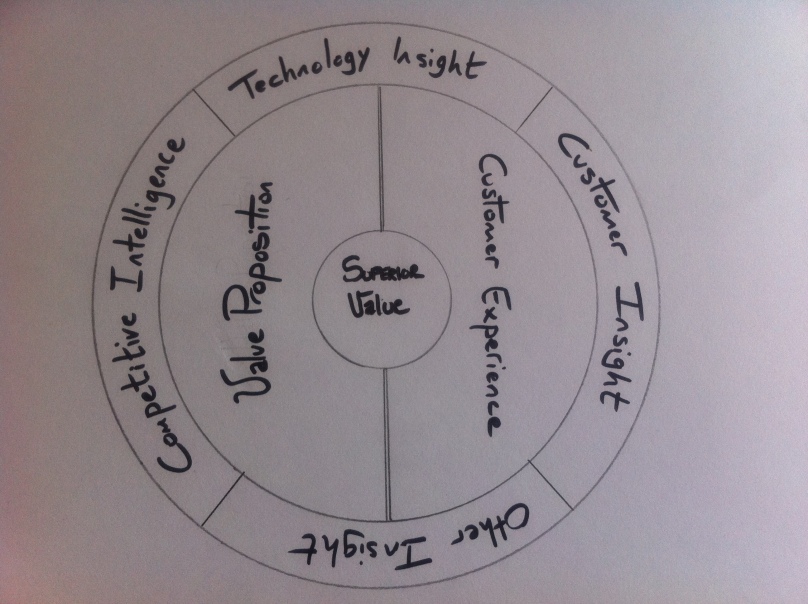A high end retailer and a discount retailer offer the same value for money
I was reading Marketing Week and the following piece caught my attention:
“Consumers perceive that John Lewis and Primark offer the same value for money, despite their widely different brand positionings, according to a new retail study.
The “Re-imagining the retail store” report, by Arc Worldwide – part of the Leo Burnett Group, found that both John Lewis and Primark scored 112 on its quantitative scale for value for money, as rated by consumers.
The scores demonstrate that both deliver good value for money, but in different ways. Consumers’ perceptions of Primark’s value stems from its low price, while John Lewis’ value perception comes from its range of choice and quality.”
How do you make sense of Customer Experience?
How do you decide when you have got the customer experience right? How does the customer experience fit / contrast with customer service? How does customer experience fit into the bigger picture? Put differently if customer experience is the foreground then what it the background (the context) into which it fits? I have been grappling with these questions and want to share my thoughts with you and get your feedback.
Here is how I make sense of Customer Experience:

In my way of thinking the focus of enterprise effort should be to create (and communicate) superior value to the customer segments that the Tops have decided to focus upon – to serve. So that is why “Superior value” sits at the centre of my thinking and this diagram.
Which begs the question: how do you create superior value? My answer is made up of two parts. First, you have to come up with (and communicate) value propositions that meet customer needs/wants – whether these needs and wants are expressed or not by the customers themselves. Second, you need to deliver a customer experience that matches the promises implied within the proposition. And the brand plays a role because there are a set of promised associated with the brand by customers and these are inherent in any value proposition. For example, you will expect different stuff when you think of Mercedes and say GM.
The key point I want to stress is that in this framework we can think of the value proposition as the promise – the bargain that is being struck between the customer and the enterprise. And the customer experience is the delivery of that bargain as experienced (lived) by the customer.
If you think about value, value proposition and customer experience then the fact that a high end retailer and a discount retailer as perceived as being par on value makes perfect sense. They both excel because they have crafted value propositions that speak to their chosen customer segments and deliver the customer experience that goes with the value proposition.
How do you craft the right value proposition and associated customer experience? This is where insight comes into play. In my model I distinguish four different types of insight: customer insight – your customers needs, wants, behaviours; competitive intelligence – what your competitors are up to; technology insight – what technology enables and how it disrupts what is taken for granted today; and other insight for example regulation around how you treat customers, privacy etc.
The final point I want to make is that I strive to think like a ‘systems thinker’ and I see all of these pieces as being interdependent. Each affects everything else. So customer insight informs the value proposition and the customer experience. Yet the customer experience will inform/feed customer insight and the value proposition cannot be developed solely based on customer insight: competitive intelligence has to be factored in because we, humans, make sense of things through comparison and contrast. You may have a great value proposition and customer experience yet if your customer comes up with a better value proposition then you are likely to find yourself in trouble: think Nokia, think RIM.
Customer Experience Management – a tentative definition
I take the view that all knowledge is provisional and as such I offer you my ‘faulty’ yet ‘rigorous’ definition of Customer Experience Management:
Customer Experience Management is the practice of designing, orchestrating and overseeing the efficacy of customer interaction (direct and indirect) such that the phenomena (experience) and outcomes of these interactions as a whole deliver on the promises implied by the value proposition and meet-exceed the expectations (implicit and explicit) of the customer, the customer facing agent and the management of the enterprise.
If you want a much simpler definition then here it is:
all the stuff that you need to do to create happy customers, have them stick with you, incentivise them to ‘recruit’ new customers for you (free of charge) AND to do this in a way which delivers a fair reward for the investment/sacrifice that you make in time, money, effort and risk.
What do you think?
I’d love to get your feedback on what I have written here. So what do you think?



